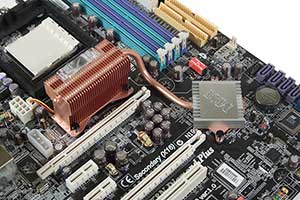MSI K8N Diamond Plus nForce4 SLI X16 Motherboard
When first looking at the overall design of the MSI K8N Diamond Plus platform, we actually considered the design to be quite cluttered, as the board's oddly colored ports and slots stood out from the platform's jet black PCB. Upon closer inspection, however, we've come to realize that the K8N Diamond Plus is meticulously designed for the needs of the high-end gamer / enthusiast. In fact, it's one of the most well designed Socket-939 SLI platforms we've seen to date.
|
|

|
Starting up north we have a standard Socket-939 CPU socket with AMD's required plastic heatsink retention clips. The board fully supports Athlon 64/X2/FX processors, as expected, and supports 1000 MHz Hypertransport link speeds, on par with other nForce4 SLI X16 platforms. The processor socket is surrounded by a three-phase VRM component system, whose low-profile keeps the area around the CPU socket quite clean. Oversized heatsinks should not be an issue on this motherboard, as MSI has left plenty of room for airflow around the socket itself. MSI has an 8-pin +12V ATX power connector near the CPU socket, although an 8-pin connector is not specifically required (a 4-pin works fine too). However, the power supply must have a full-sized 24-pin primary ATX connector (located between the memory and IDE slots)
AMD Socket-939 processors can support up to 4 GB of DDR-400 memory. The board has four 184-pin DDR DIMM memory slots, colored in such way to separate the DDR memory channels (green channel one, purple channel two - easy enough). As with all Socket-939 platforms, dual channel DDR-400 memory provides up to 6.4 GB/s of peak memory bandwidth, which doesn't seem like a lot today as Intel platforms can push theoretical bandwidth levels of 10+ GB/s, although AMD's memory controller design isn't as dependant on memory clock speeds and bandwidth like Intel's are.

|

|
The nForce4 SLI X16 chipset itself is split up into two actual chips, the nVidia C51D and the nVidia CK804. It's a little different compared to a traditional Northbridge/Southbridge setup, as each of these chips controls one of the PCI Express x16 graphics card slots (among other things). The nForce4 Ultra and SLI chipset products only have 20 PCI Express lanes to utilize, which makes true 16 x 16 SLI impossible. The dual-chip nForce4 SLI X16 chipset supports 38 PCI Express lanes, which allows each graphics card slot a full set of PCI Express lanes to utilize for zero performance slowdowns. While it's never been proven that the extra PCI Express bandwidth truly helps (even with the most high-end cards on the market today still run at 95-99% of their speed on PCI Express x8), top of the line gamers want to know that there are no potential performance bottlenecks in their way.
While the dual-chipset is design is good for performance, it's not so good in terms of heat. Each nForce4 chip creates quite a lot of heat and sucks down a lot of power, so motherboard makers have been forced to come up with some innovative methods in order to get this heat away from the system while still maintaining a quiet operating environment. MSI's method of dealing with this heat is an interesting contraption, featuring two copper-base chipset coolers which are connected via a copper heatpipe. The primary chip is attached to a set of tall copper thin-fins, which has an embedded 40mm cooling fan. MSI claims that this cooler not only cools the chipset, but the excess airflow also will help cool down the back of the primary graphics card installed in the system.






